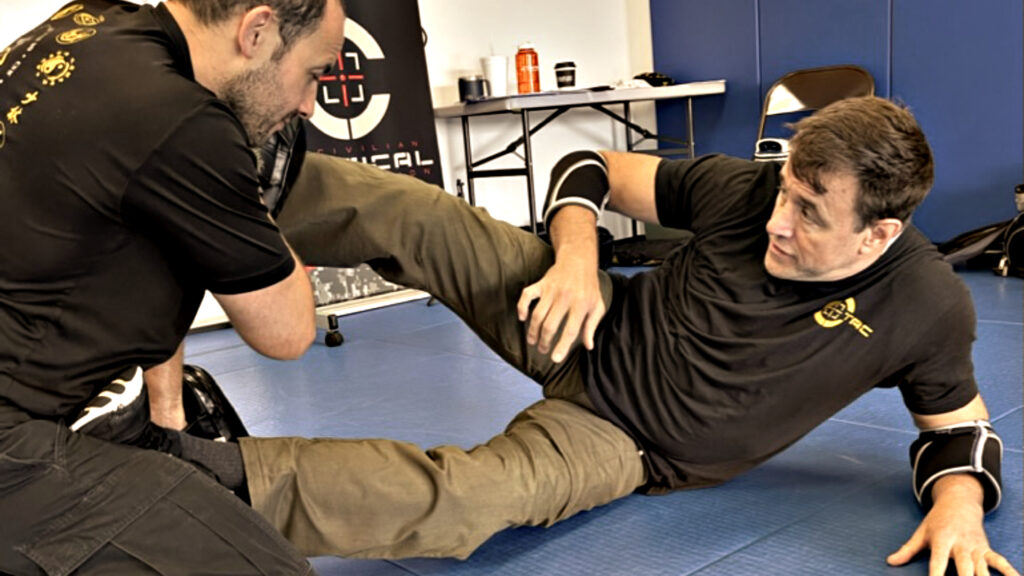
It is no secret that grappling and wrestling have become incredibly popular in the last 20-plus years. And this is a great thing because, as we all know, at one time, there was a significant gap in knowledge in the industry around this righting range. Thus, this surge in popularity has significantly contributed to the expansion of universal knowledge in ground fighting techniques and training methods.
But due to the grappling zealots that are now excessively focused on just one area, you see this training idea showing up more and more in the firearms and weapons-based communities, and that is not the best option for this area. Attempting to execute an armbar on an armed assailant while in your guard position is far from advisable. However, such techniques and ideas are commonly taught in the defensive tactics community.
One of the contributing factors to this trend is the proliferation of “instructors” who possess expertise limited to only one or two martial arts systems. Frankly, such a narrow scope of knowledge is insufficient for adequately addressing the broad subject of self-defense. While it may suffice for teaching the specific art they have mastered, venturing into the realm of self-defense demands more comprehensive training, education, and understanding. Attempting to navigate self-defense with such constrained background and knowledge poses significant risks to individuals. The sight of these individuals with limited backgrounds teaching law enforcement or other professionals is even more concerning. This is an essential factor to consider when selecting a training path or instructor.
Let me clarify: I have a profound appreciation for grappling and submission wrestling. I’ve dedicated decades to training in multiple wrestling and grappling systems. Training in grappling not only hones specific techniques but also cultivates vital attributes that significantly improve overall fighting capabilities. Individuals develop acute timing through grappling, allowing them to anticipate and counter their opponent’s moves more effectively. Sensitivity to opponents’ movements and intentions becomes sharper, enabling a more intuitive response during combat. Grappling also builds mental and physical toughness, preparing practitioners for the rigors of close combat. Moreover, the ability to flow smoothly from one technique to another without hesitation is enhanced, making fighters more adaptable and fluid in their strategies.
The rigorous physical demands of grappling sessions serve as an excellent form of conditioning, ensuring that practitioners remain in peak physical shape, ready for combat. This concept of using combat sports to maintain fight readiness is not exclusive to grappling. The sparring environments found in Thai Boxing, Burmese Boxing, and STX Kickboxing similarly offer exceptional opportunities for physical conditioning.
However, my admiration for these disciplines doesn’t blind me to the reality that grappling alone does not constitute fighting. An example is if you are pined to the ground, you will need to know how to survive, improve your position and make enough space to free up your tools to start striking and delivering more destructive force on your opponent. I’m not sure if a submission or a choke will have enough stopping power against a predatorial hardened threat.
As I mentioned, Grappling undoubtedly plays a crucial role in ground encounters, but it’s not the ultimate solution. More often than not, it serves as a means to strategically position oneself to engage in combat. In other words, you are not “grappling to grapple,” but you are “grappling to fight.” Grappling systems will develop the habit of being comfortable flat on their back. And in actual fighting encounters, this is never a good place to be. I often tell my students to make their opponent “earn flat” and never give them flat! This habit of being comfortable flat on the ground can become ingrained into your nervous system. This ingrainment is not bad in a Jiu-Jitus class, but it will work against you on the street.
Furthermore, the introduction of an everyday carry (EDC) training kit dramatically alters the fundamentals within the grappling environment. Traditional grappling methodologies were not originally developed with the consideration of being armed. The foundational principles were established independently of this concept. Consequently, integrating EDC elements into grappling reveals the necessity for fundamental adjustments. You must remain constantly vigilant of both the firearm and the blade, ensuring the protection of your own weapons while staying prepared in case your opponent attempts to draw a weapon. Comfort in common defensive grappling positions is no longer an option; you must prevent them from occurring altogether. Your mindset must shift to one where grappling is only a last resort forced upon you by your opponent, especially when armed.

With over three decades of training across various grappling systems, my experience underscores this paradigm shift. Upon incorporating an everyday carry training kit into my sessions, I swiftly recognized the imperative need for adaptation. The realization dawned that numerous aspects of my grappling fundamentals demanded complete reevaluation and modification.
Another significant realization dawned upon me: there were evident gaps in knowledge regarding ground encounters. It became apparent that grappling constituted just one facet of study when confronted with being grounded. The subsequent area of focus emerged as ground fighting. Ground fighting extends beyond grappling to encompass striking techniques and the challenge of simultaneously contending with multiple opponents. This training and mindset change is one factor that led me to develop the C-Tac® System. Upon integrating my everyday carry kit into my diverse training regimes, I swiftly recognized the necessity for significant adjustments, extending even to the core principles of the systems I explored. This adaptation illuminated a substantial void in knowledge regarding such practices within the martial arts industry.
Another vital field of exploration is termed Anti-Grappling, which delves into the intricacies of grappling techniques with the aim of identifying a grappler’s objectives and subsequently devising strategies to counteract these moves during combat. This area of study meticulously examines the universal principles and tactics grapplers employ to gain control and deliver severe structural damage to the threat in a physical confrontation.
By gaining a deep understanding of these foundational elements, one can anticipate and neutralize the maneuvers of an opponent whose primary strategy revolves around grappling. Recognizing the key objectives that grapplers strive to achieve within the grappling domain provides a significant tactical advantage. This knowledge equips individuals with the tools to craft a comprehensive and effective counter-strategy, turning the opponent’s grappling-focused approach into a vulnerability rather than a threat. Through strategic planning and the application of anti-grappling techniques, one can effectively mitigate the grappling threat and maintain a dominant situation in the fight.
Understanding various combat strategies beyond one’s primary discipline can significantly enhance your ability to disorient and dominate your opponent by shifting the battle to a context they are less familiar with. For instance, compelling a boxer to engage in a grappling match removes them from their comfort zone of striking and footwork, thrusting them into a scenario where their usual tactics are less effective. The aim here is to expand our tactical horizon, fostering a comprehensive understanding of the myriad possibilities within ground fighting. By acquiring this knowledge, we equip ourselves with the ability to maneuver our opponents away from their standard modes of operation during combat. This strategic displacement confounds them and tilts the balance in our favor. It’s about exploiting the full spectrum of combat techniques to create situations where we can leverage our multifaceted training against an opponent’s narrower focus, thereby gaining a critical advantage in the encounter.
If your journey through the Martial Arts community has left you seeking answers that resonate with the everyday carry and tactical sphere, and you’ve yet to find a solution that aligns with your needs, consider exploring the Civilian Tactical program. It might just offer the direction you’ve been searching for. My goal is to cultivate more individuals with the warrior mindset and leadership qualities necessary to confront challenges head-on, particularly in times of crisis. I imagine a world where more people are prepared and eager to confront the growing challenges and malevolent forces.
Shift Your Perspective, Take the Action, Transform Your World.
~ Sifu Alan
The Warriors Path Podcast With Sifu Alan Baker
Civilian Tactical Training Association Instructors Program

Alan Baker is celebrated for his exceptional skill in creating customized Defensive Tactics Programs and his prowess in high-performance coaching. Tailoring his expertise to meet the needs of law enforcement agencies, military groups, and security companies, Alan crafts training curriculums that are grounded in practical techniques, adaptability to real-life scenarios, and intensive, situation-specific exercises. His training methodologies are meticulously designed to elevate the operational effectiveness and situational preparedness of individuals in high-stakes environments. Learn more about Alan’s distinctive programs here.
Beyond his tactical acumen, Alan is also a foremost “mindset” coach, adept at tapping into the untapped potential within individuals. He is particularly attuned to the current societal trend that often overlooks traditional masculinity and the cultivation of strength. Addressing this, Alan champions the development of a warrior spirit — the readiness to confront chaos and take decisive action when necessary. He passionately mentors professionals, entrepreneurs, and individuals on their personal development journeys, focusing on fostering a mindset dedicated to excellence. His coaching is anchored in pragmatic strategies that fortify mental resilience, enhance focus, and stimulate drive. Engaging with Alan sets you on a transformative journey where mental obstacles are overcome, innate strengths are recognized and honed, and your objectives become distinctly attainable. His insights are key in boosting performance and developing a mindset geared for victorious accomplishments.
For a deeper exploration of Alan’s mindset philosophy and his approach to empowering especially men to embrace their strength and resilience, delve into his insightful collection of books. If you’re ready to accelerate your personal and professional growth under Alan’s expert guidance, connect through his official website.

